
As part of preparing content for this Spring’s “People In the Environment” section I’m teaching on American Environmental History, I’m “porting” my textbook over to a full-on OER (open educational resource). This should allow me to make the content available to students in a less expensive and more flexible version, in both print and ebook formats, as well as making the chapters available to other educators as stand-alone modules they can mix and match, remix, rewrite, etc. As I do that, I’ll be able to add CC content from elsewhere and link to outside text, graphics, and video, as well as including narration and possibly even links to my lectures in the electronic version of the text. I believe Pressbooks allows for linking and embedding, and Camtasia allows adding interactive elements like quizzes along the way in the text. I’m going to try to incorporate both.
So the new elements I’ll be adding to my text will include color (!), fonts, revised format, quizzes and discussion prompts (possibly links), audio narration, videos from the web (YouTube, Archive), and links to my Camtasia lectures. I’ll also be updating the content. I think I’ll continue with the 15 chapters = 15 weeks format. But I might throw in some additional chapters that people could swap in or use as extra credit opportunities if they chose. The goals of many of these chapters is not to cover the topics exhaustively, but to make students aware of the issues and introduce basic ideas. The outline will look something like this:
Module/Chapter 1: Prehistory
Goals: Push back the “beginning” of the story, introduce Beringia, climate change, staple crops
Module/Chapter 2: Recontact
Goals: Introduce the Columbian Exchange (Crosby), native population disaster, early commerce (silver, sugar).
Module/Chapter 3: Colonial America
Goals: Compare Euro and native land use traditions (Cronon), Examine role of religion justifying colonialism, impact of slavery on land use.
Module/Chapter 4: Frontier & Grid
Goals: Understand role of western expansion in Revolution and early republic, consider barriers to expansion (Proclamation Line, Free Soil debate, Trail of Tears), describe pioneer life, immigration.
Module/Chapter 5: Industrial Revolution
Goals: Examine changes caused by industrialization on use of commons, incorporation, labor, economic and environmental externalities. (Steinberg)
Module/Chapter 6: Transportation Revolution
Goal: Understand changing technology and public policy around development of canals, steamboats, railroads. Consider tension between public and private sectors in issues like land grants, monopoly. Continue to automobiles and highways (with extra material on ethanol vs. leaded gasoline), air travel and containerized freight.
Module/Chapter 7: Commodities
Goal: Examine shift to a commodity market: population changes, new industries in packing (pork & beef) and their discontents (The Jungle), ice, lumber (and fires), flour (and populism).
Module/Chapter 8: Green Revolution
Goal: Cover beginning of commercial agriculture, ag. Improvement (manure, rotation), green manure (alfalfa), guano (Incas, Liebig, Humboldt, Chinese labor, Chincha Islands War, Guano Islands Act), Nitrate (Caliche, War of the Pacific, Haber-Bosch process), Phosphorus and Potassium, Hazards and pollution (Gulf Dead Zone), the Dust Bowl, Ogallala Aquifer, Export of Green Revolution to Developing World (Borlaug, Indian debt and suicide).
Module/Chapter 9: City Life
Goal: Examine what cities are for. Consider American colonial cities built on native cities (Cuzco, Mexico City, Plymouth), Land Reclamation and filling wetlands (Mexico City, New York, San Francisco), Sanitation and water supply (New York, Boston, San Francisco, Los Angeles), symbiosis with hinterlands, Horses and mechanized transport, Urban reformers, parks and suburbs, contemporary exurbs and CSA.
Module/Chapter 10: Wilderness and Country Life
Goal: Distinguish between Conservation and Preservation movements (Muir v. Pinchot), examine ideas of wilderness (Cronon) and exclusion (Jacoby).
Module/Chapter 11: Farmers and Agribusiness
Goal: Examine America’s change from a country of farmers to an urban nation, implications for farmers, rural life, consumerism, politics.
Module/Chapter 12: Treasure Underground
Goal: Examine the mining and drilling of underground resources: Cerro Rico silver, ideas of subsoil ownership, copper, iron and steel, gold rushes, petroleum (in the world, the US, and the relationships between corporations, government, foreign policy).
Module/Chapter 13: Population and Limits
Goal: Examine Malthusian ideas, challenges to them such as #stopthemyth and Rosling’s demographics, consider controversies over Population Bomb, Limits to Growth, peak oil.
Module/Chapter 14: Externalities
Goal: Review the ways economics deals with the idea of externalities, with examples. Politics, Globalization, Dependency.
Module/Chapter 15: Environmentalism
Goal: Review American people’s concern over environmental issues. Consider alternatives to contemporary lifestyle. (incorporates “Food and Choice” chapter from book with survey of environmentalists.



